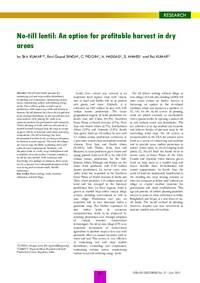No-till lentil: An option for profitable harvest in dry areas

Authors:
No-till lentil holds promise for minimizing soil and crop residue disturbance, controlling soil evaporation, minimizing erosion losses, sequestering carbon and reducing energy needs. These effects reduce overall cost of production while improving yields and returns to farmers. No-till planters have been developed that cause minimal disturbance to the soil and previous crop residues while placing the seeds in an optimum position for germination and emergence. Timely planting of lentil under no-till systems in rainfed lowland ecologies help the crop to escape negative effects of terminal water stress and rising temperatures. No-till technology has been demonstrated at farm levels, resulting in adoption by farmers in some regions. The main advantages are cost savings, flexibility in planting times and reduced water requirements. Problems with adoption relate to weeds, crop establishment and availability of no-till seeders. Varieties suitable to no-till are also needed. With awareness and knowledge of a package of practices, these issues can be overcome for widespread adoption of this cost saving and environmentally friendly technology.
